CASE STUDY 7
Living Planet Centre – WWF
Woking

Overview
The Living Planet Centre houses 340 staff over two storeys in a collaborative, open-plan environment, together with conference and educational facilities and the new WWF Experience, which welcomes members of the public into the building. The building is suspended above an existing council car park alongside the Basingstoke Canal on the outskirts of Woking. Office space is arranged on two levels around a double-height internal street that gives focus and sociability to the internal environment. Two hundred ‘hot’ desks are provided for staff at a ratio of 5.88 desks per ten staff, determined following a detailed review of the office culture and space usage in WWF’s previous headquarters (Figures 02 and 03).
The construction cost was mainly funded through a capital appeal, to avoid diverting funds from conservation projects. During the long search for a suitable site the client team set about refining a comprehensive brief for the project, with the aim of creating an exemplar for working practice, resource efficiency and for the use of low embodied energy and non-polluting materials.

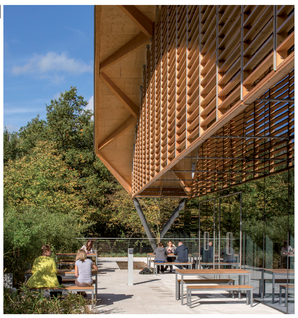
01 External view: timber louvre screen on west elevation

02 First-floor plan: public entrance, conference and education space to the east (right side of image)
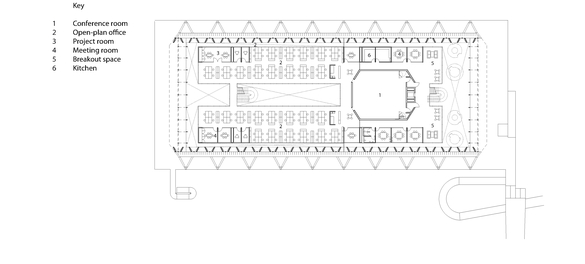
03 Mezzanine plan with main conference room
Design approach
The building’s raised plinth and mezzanine are constructed of high-quality fair-faced concrete with a high proportion of cement substitute (ground-granulated blast furnace slag, or GGBS). Its roof is a dramatic structural timber gridshell, 37.5m wide. This is capped with recycled aluminium roofing featuring photovoltaic panels and large metal wind cowls to assist with the ventilation of the building. The eastern and western ends are glazed, with timber louvres providing protection against solar gain (Figures 06 and 07). The open-span nature of the structure allows for easy future adjustment of internal layout, and works with the raised floor’s inherent flexibility to help future-proof the building.
The project benefits from of state-of-the-art IT systems, partly donated in kind, and based around refurbished technology from the 2012 Olympics. WWF monitors and annually reports on all of its employees’ domestic and international travel and uses high-quality video conferencing to help reduce transport-related carbon impacts.

04 Front elevation

05 Side elevation
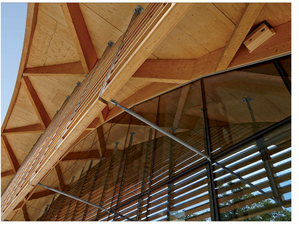
06 External view

07 Internal view from first-floor mezzanine, looking west

08 Good daylighting is achieved across all of the deep-plan floor plate, but there are no views out from the first-floor work stations
Environmental design
The open office areas are designed to promote good ventilation and to benefit from good daylighting across the deep plan, with a daylight factor of four or more across the floor plate (Figure 08). The design team worked together to manage the competing demands for roof space, balancing glazing areas for natural daylight (avoiding artificial lighting) with the area devoted to electricity production via photovoltaic (PV) panels. There is 510m2 of PV in total (55kWp), providing about 20% of the building’s regulated energy needs.96 Daylighting models and shading analysis were used to improve the access to solar radiation, resulting in a design change to the orientation of the footprint by 9°.
During the design process lengthy studies were made, researching the environmental impacts of various material and construction choices and looking at the embodied energy of particular aspects, such as increased insulation thicknesses, against the potential carbon saved. These carbon-profiling studies led to some unexpected outcomes for an ultra-low-energy building: the choice, for instance, of double rather than triple glazing in the main east and west façades.
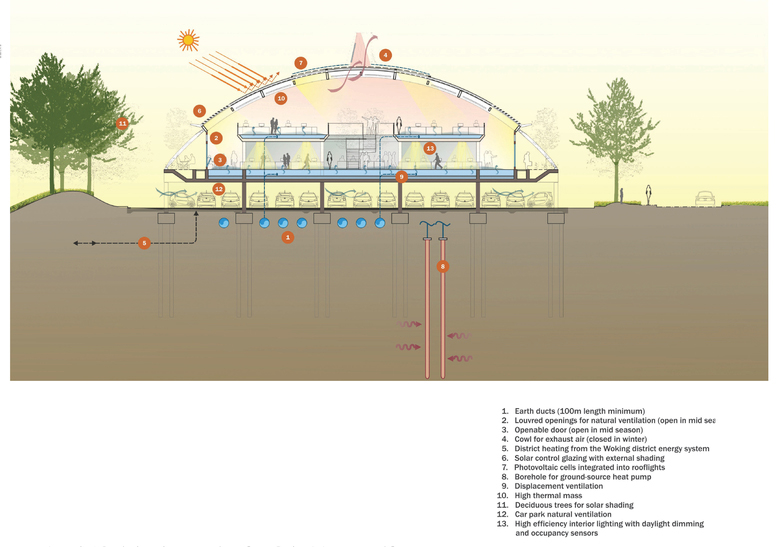
The building can operate for about two-thirds of the year in natural ventilation mode, with fresh air entering above the podium-level glazing and doors via manually operated vents. The work areas are entirely open plan and therefore air can move freely under the mezzanine floors; it is exhausted through four large roof-mounted cowls (Figures 10 and 11). Green and red indicator lights are distributed across the work areas to show whether the building is in natural or mechanical ventilation mode (an alert is also sent to everybody’s computer). In mechanical ventilation mode air is supplied via a 500mm-deep floor plenum. The air is pre-heated by a series of earth tubes located approximately 1.2m below the car park surface. Stale air is extracted from grilles around the perimeter, and heat is recovered by the air-handling units located in the undercroft parking area. The mechanical ventilation supplies tempered air to meeting rooms and the conference area throughout the year. Heating and cooling is provided by a Groenholland heat pump connected to twenty 100m-deep boreholes. The data server is also cooled by the building’s ground-source heat pumps.
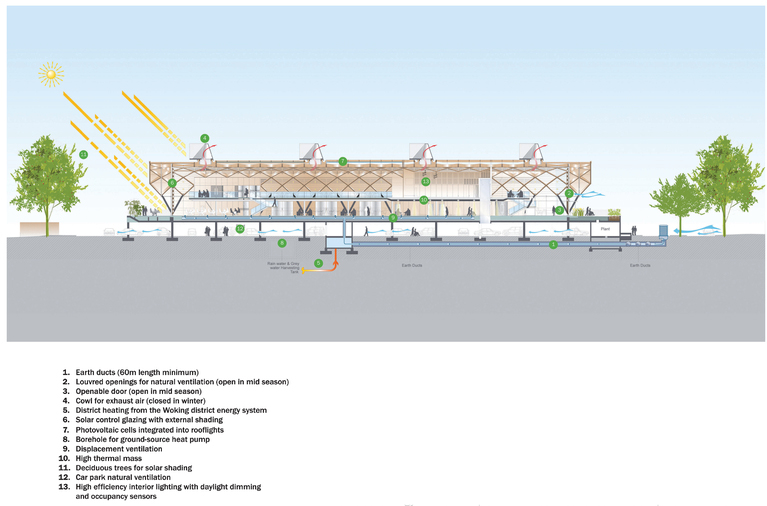
10 Heating and solar strategy: long section
Monitoring and post-occupancy feedback
The Living Planet Centre has been monitored in the first year by contractors Willmott Dixon and by WWF’s building-management team, who report regularly on the energy and water consumption of their UK buildings, and also the carbon emissions associated with travel and consumables. WWF benchmarks its performance against its own baseline and industry standards, seeking to make substantial improvements every year. The post-occupancy evaluation included energy and social performance measures. A user questionnaire was completed soon after occupation, providing useful feedback on some of the controls systems and revealing the general level of understanding of the building’s environmental systems and user interactions. The controls philosophy was explained to a wide user group at handover, and messages are reinforced in the user guide.
There were initial problems with the set-up of the building management system (BMS), which was not recording the data from sub-meters. Now that these have been overcome there are regular post-handover meetings between the building manager, the main contractor, the M&E subcontractor, controls engineers, the heat pump manufacturer and the building designers. An action plan has been devised to inform the monitoring and for making operational changes and improvements. The services engineer, Atelier Ten, can provide high-level checks on temperature and ventilation settings (they can access the BMS remotely) and the controls installer has been taken on board to provide ongoing management of the Trend controls system. The contractor also undertook smoke tests to verify the ventilation rates in the meeting rooms. As a result of these activities a number of adjustments have been made:
- extra vents have been added to the meeting rooms to increase the extraction rates
- alterations have been made to the night-purge routine to improve efficiency
- manual controls have been installed on the roof cowls
- various set points and ventilation rates have been adjusted to improve comfort
- chiller settings have been lowered on the ground-source heat pumps during summer mode.
Although the building is performing considerably better than the industry benchmarks, the first year’s energy consumption shows a discrepancy between the predicted use and metered use.97 The monthly winter average consumption (October–March) was 11.03kWh/m2 and the summer average (May–September) was 8.08kWh/m2. This gives a total energy use of 114.66kWh/m2/yr compared with the predicted energy use of 74.87kWh/m2/yr.98
The public areas of the building, the conference and educational facilities, have proved very popular and as a result the operating hours are longer than anticipated. These are also the areas that have the most active conditioning and energy usage. Work is ongoing to establish how much of the difference between predicted and actual usage can be attributed to under-performing fabric and services and how much is as a result of incorrect or enforced assumptions (by regulation and compliance conventions) in the prediction model.

11 External view: rooftop ventilation cowls
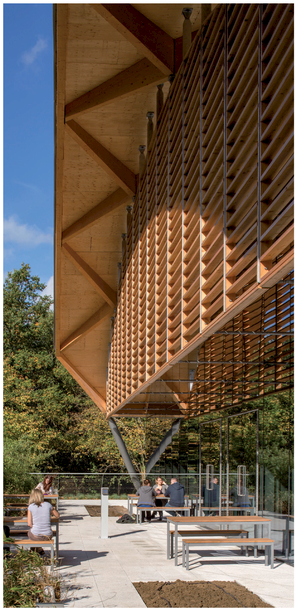
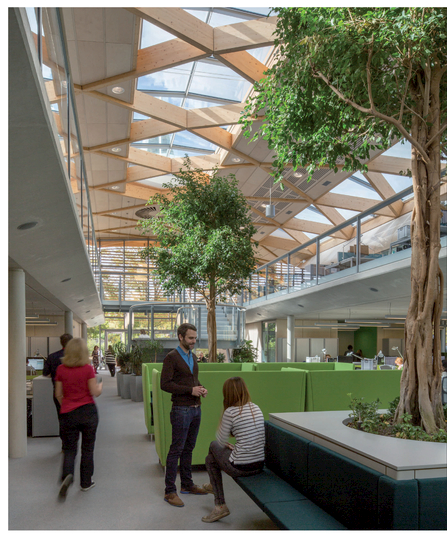
13 Internal view from ground floor looking west
Conclusions
The Living Planet Centre is a project where the client’s ambitions have been clearly researched in a demanding but clearly articulated brief, which has prompted imaginative and collaborative working from an enthusiastic and knowledgeable delivery team. Innovative work has been undertaken with regards to operational and embodied energy, and this has informed construction techniques, material choices and engineering solutions from first principles.
The carbon-profiling work has also helped to achieve a balance between carbon associated with embodied energy, the ‘capital’ carbon cost of installation, and the long-term potential savings in operational carbon emissions over the life of the building. As a result there was a greater focus on reducing the embodied energy of the construction.
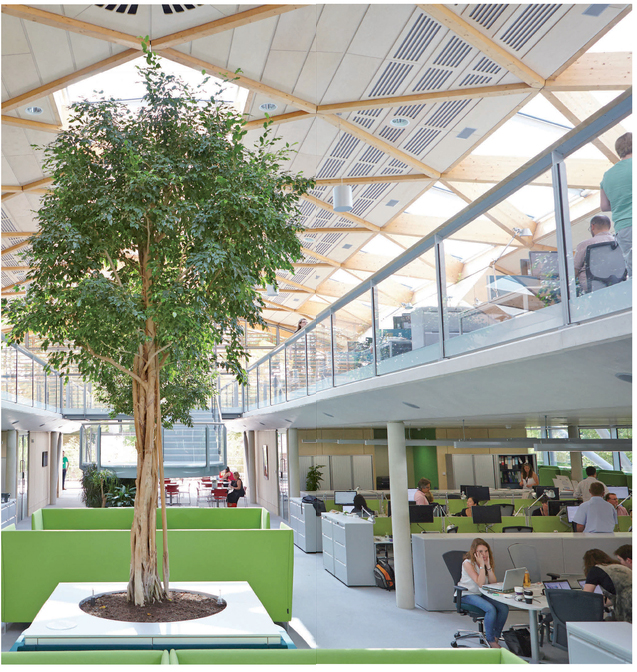
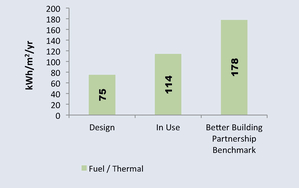
15 Energy and carbon graph
